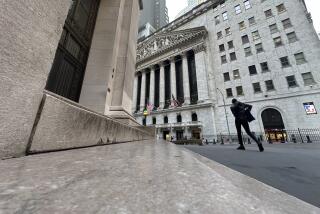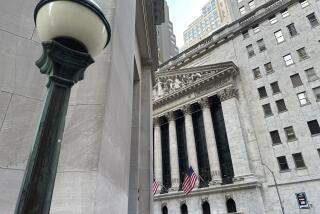Bonds Hurt by Fear of Foreign Rejection
Long-term interest rates surged on Monday, driving the yield on the bellwether 10-year Treasury note to its highest level in nearly four months, on more concerns that foreign investors might lose their appetite for U.S. bonds.
The stock market largely shook off bonds’ woes, with key indexes recovering from an early sell-off to end mixed. The Dow Jones industrial average slipped 46.33 points, or 0.4%, to 10,475.90, while the technology-dominated Nasdaq composite edged up 4.90 points, or 0.2%, to 2,106.87, a 10-month high.
In the bond market, the 10-year T-note yield jumped from 4.23% on Friday to 4.32%, its highest level since Aug. 5. The T-note rate is a benchmark for mortgages, so it may signal that home loan rates will climb soon.
Long-term interest rates had been flat or falling in recent months. But the continuing slide in the dollar’s value began to spook some bond investors on Nov. 19, when Federal Reserve Chairman Alan Greenspan warned in a speech that foreigners eventually would become less willing to finance the nation’s huge budget and trade deficits.
Foreign investors, in particular Asian central banks, have been big buyers of Treasury bonds in recent years. If those investors began to sell their holdings, they could drive bond prices down and their yields up. Bond prices and yields move in opposite directions.
The bond market was rattled Friday after a Chinese central bank official was quoted as saying the bank had trimmed its Treasury holdings this year. The official later said the report was misconstrued.
On Monday there were more rumors of Treasury sales by foreign investors. But several traders said there were no actual signs of such sales. The reports were “total speculation,” said Gregg Cohen, a bond trader at CIBC World Markets in New York.
Indeed, the dollar strengthened modestly Monday against key currencies. The euro slipped to $1.327 from $1.329 on Friday. The dollar rose to 102.82 yen from 102.56.
Had there been heavy foreign selling of U.S. securities, the dollar would have been expected to slide further.
Still, Cohen and other traders said some investors were nervous enough about the possibility of bond sales by foreigners in the weeks ahead that they were taking some money off the table, to be safe.
Bill Gross, who oversees the world’s biggest bond fund at Newport Beach-based Pacific Investment Management Co., advised clients in a commentary on the firm’s website Monday to be “careful with U.S. Treasuries,” saying that a change of heart by foreign investors could be “just around the corner.”
Gold, which has been a big beneficiary of the dollar’s slide as investors have searched for an alternative that would hold its value, climbed $4.40 to $453.70 an ounce in near-term futures trading in New York on Monday. It was the highest price for the metal in that market since 1988.
Technical factors also triggered Treasury bond sales on Monday, said Brian Edmonds, head of Treasury trading at Banc of America Securities in New York. A number of major U.S. companies are expected to borrow money via bond offerings this week, so some big investors were selling government bonds as a hedge before buying the corporate issues.
Whatever the reasons for the turnabout in long-term interest rates, the risk is that it could feed on itself between now and the end of the year, Edmonds said.
“It feels to me like we’re going to see higher long-term rates” in December, he said.
The bond market faces a potential hurdle Friday, when the government is scheduled to report on November employment trends. Wall Street is expecting the report to show that a net 200,000 jobs were created this month. A bigger number could raise concerns that the economy is accelerating, raising inflation fears and making it more likely that the Federal Reserve would continue to lift short-term interest rates.
Jangled nerves in the bond market initially helped to drive stock prices down Monday. The equity market also was hit by worries about holiday retail sales, after industry leader Wal-Mart Stores lowered its November sales growth estimate.
The Dow Jones industrial average, which includes Wal-Mart, was down as many as 105 points early Monday. But the loss was cut in half by the closing bell, even though Wal-Mart gave up $2.17 to $53.15.
The Standard & Poor’s 500 index eased 4.08 points, or 0.3%, to 1,178.57, as losers outnumbered winners by about 4 to 3 on the New York Stock Exchange.
Shares of home builders hurt blue-chip indexes, as investors sold the stocks on worries about mortgage rates. KB Home slumped $3.10 to $88.31 and Ryland Group lost $4.26 to $101.72.
But winners topped losers by 4 to 3 on Nasdaq, as Apple Computer led many technology shares higher. Apple soared $3.89 to a four-year high of $68.44 on optimism about sales of its iPod music players. Among Internet-related shares, EBay gained $1.15 to a record $112.65.
Two key indexes of smaller stocks, the Russell 2,000 and the S&P; small-cap 600, hit record highs Monday, continuing their recent winning streaks.
Many analysts say the stock market is benefiting from optimism about the economy in 2005, even as interest rates rise.
Richard McCabe, chief market analyst at Merrill Lynch, said he was impressed with the broad-based nature of the stock market’s advance in recent weeks, as investors have snapped up shares across many unrelated industry groups. That strength “implies further upside potential for the market in coming months,” McCabe said.
More to Read
Inside the business of entertainment
The Wide Shot brings you news, analysis and insights on everything from streaming wars to production — and what it all means for the future.
You may occasionally receive promotional content from the Los Angeles Times.










